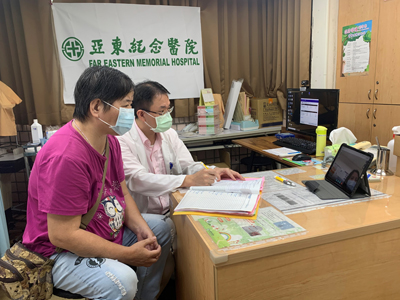04.2024 Cover Story
Far Eastern Memorial Hospital's digital transformation makes healthcare smarter
Far Eastern Magazine / Editorial Room


 In a busy and high-pressure life, no one likes to wait, especially for patients and their families who feel physically uncomfortable or anxious. Waiting for registration, examination, queuing for medication, etc., is agonizing every minute. As the global healthcare workforce gap gradually expands and labor costs continue to rise, it is an urgent issue in the medical industry to reduce the workload of healthcare workers, improve healthcare efficiency, and reshape the new appearance of medical services through smarter and more streamlined processes.
In a busy and high-pressure life, no one likes to wait, especially for patients and their families who feel physically uncomfortable or anxious. Waiting for registration, examination, queuing for medication, etc., is agonizing every minute. As the global healthcare workforce gap gradually expands and labor costs continue to rise, it is an urgent issue in the medical industry to reduce the workload of healthcare workers, improve healthcare efficiency, and reshape the new appearance of medical services through smarter and more streamlined processes.
 The three-year COVID-19 pandemic has had a profound impact on the global industry, with the healthcare industry being the first to bear the brunt, especially with the indirect impact of manpower shortages on financial and operational models; Even after the epidemic, the shortage of medical care remains a difficult problem to be solved.
The three-year COVID-19 pandemic has had a profound impact on the global industry, with the healthcare industry being the first to bear the brunt, especially with the indirect impact of manpower shortages on financial and operational models; Even after the epidemic, the shortage of medical care remains a difficult problem to be solved.
Fortunately, the rise of AI and Big Data has accelerated the application of technologies such as remote healthcare, electronic medical records, and AI assisted diagnosis, which has also brought dawn to medical empowerment and digital transformation. If digital management can be achieved through data analysis and information systems, optimizing processes, and maximizing the utilization of medical equipment, materials, and other resources, it can effectively shorten the length of hospital stay for patients, enable waiting patients to be admitted for treatment early, reduce emergency congestion, and maximize the efficiency of bed placement. To this end, Far Eastern Memorial Hospital aims to plan and promote three key areas: friendly experience, streamlined processes, and value creation.
1、 Optimize the medical process for a friendly experience
Mobile payment is a global trend, and Far Eastern Memorial Hospital introduced the "Medical Payment App" in 2018, which facilitates quick payment by patients and allows family members to help with payment, greatly reducing the waiting time for approval after seeking medical treatment. Under the promotion of multiple channels, the number of users has been increasing year by year. In 2020, efforts were made to establish a "one-stop service for nursing station discharge". After paying through the "Medical Instruction Payment App", the public can quickly complete the discharge procedures at the nursing station, including medication, fee receipts, and diagnostic certificates. This also relatively improves the admission time for new patients. The excellent results were recognized as the first place in the "Medical Expense Action Payment Introduction Process Optimization and Improvement Competition" by the Ministry of Health and Welfare in 2022. In 2023, the scope of use of the "Medical Payment App" will be expanded from outpatient, emergency, and inpatient services to convenient services such as applying for medical record copies, further enhancing the public's medical experience.
 On the other hand, in order to avoid patients waiting for beds for a long time, Far Eastern Memorial Hospital not only displays the waiting bed situation of each department on the emergency navigation machine, but also captures the retention dynamics of emergency patients and analyzes the empty beds of inpatients every hour, effectively and instantly adjusting the bed configuration; In 2023, a dual track system of system bed booking and telephone notification will be implemented. The intensive care unit will respond to the booking results through the system, and the system will automatically bring back emergency medical orders, achieving two-way communication and shortening the waiting time for beds in the intensive care unit.
On the other hand, in order to avoid patients waiting for beds for a long time, Far Eastern Memorial Hospital not only displays the waiting bed situation of each department on the emergency navigation machine, but also captures the retention dynamics of emergency patients and analyzes the empty beds of inpatients every hour, effectively and instantly adjusting the bed configuration; In 2023, a dual track system of system bed booking and telephone notification will be implemented. The intensive care unit will respond to the booking results through the system, and the system will automatically bring back emergency medical orders, achieving two-way communication and shortening the waiting time for beds in the intensive care unit.
As for the general acute ward, actively coordinating with the oncology department, it is expected that inpatient chemotherapy cases will be admitted on Friday, completed on Saturday after chemotherapy, and discharged on Sunday to improve the utilization rate of holiday beds. Recently, we have also utilized hospitalization data from the past 5 years to estimate bed demand, and built a Tableau data dashboard to monitor empty beds. We have set thresholds to notify emergency waiting conditions, and adjusted our colleagues' attendance to allow more nursing professionals to spend the holiday with their families. In addition, for the limited number of differential wards, the "routine treatment self-control signing in differential wards" is currently being piloted by departments such as cardiology and orthopedics. In the future, the flexibility and operational efficiency of bed use will be promoted to other departments. Of course, in situations where the number of nursing staff and open beds is limited, each bed is a precious medical resource. Therefore, if the self controlled beds of each department are not signed for by 22:00 on the same day, they will be recycled as central control beds for flexible use of the entire hospital bed.
In addition to rolling dynamic bed control, if it can shorten the length of hospital stay for patients, it can also help activate bed utilization. Therefore, Far Eastern Memorial Hospital takes the lead in planning and promoting the "surgery before hospitalization" process, initially selecting surgical cases with shorter hospitalization days and treating them with a "virtual bed number" to identify patients and prescribe preoperative medication. After the bed is confirmed, it is then converted to an actual bed number; In addition, it also cooperates with the adjustment of the relevant functions of the eight major systems, including outpatient orders, surgical scheduling, and bed signing, to facilitate the linkage between processes and the consolidation of relevant information.
In addition to shortening waiting time, strengthening medical communication is an important part of a friendly experience. In order to solve the problem of patients often forgetting to tell their doctors when entering the clinic, Far Eastern Memorial Hospital has been promoting "patient participation" since 2023. Patients or their families can scan the QR code in front of the outpatient clinic before waiting, fill in the purpose of consultation, chief complaint symptoms, and epidemic prevention TOCC, etc., to facilitate the understanding of doctors; In the emergency department, consultation content can also be established for cases with level 4-5 injuries, and relevant disease certification teams can be invited to participate in the research and discussion; When hospitalized, the admission assessment questionnaire can also be completed first to better meet the needs and expectations of patients during the treatment process. In the future, the participation of patients in other projects will also be continuously promoted.
2、 Link internal data refinement process
 The digital transformation of medical institutions has become a trend, and Far Eastern Memorial Hospital has been introducing various electronic consent forms since 2010. This not only reduces paper usage, but also simplifies administrative tasks such as medical record archiving. The first stage starts with hospitalized patients, providing hospitalization consent forms, emergency patient referral consent forms, and meeting audio or video consent forms; The second stage extends to the consent forms for surgical anesthesia for emergency patients, and further promotion of consent forms for outpatient patients for surgical anesthesia, self payment, etc. will be carried out in 2023.
The digital transformation of medical institutions has become a trend, and Far Eastern Memorial Hospital has been introducing various electronic consent forms since 2010. This not only reduces paper usage, but also simplifies administrative tasks such as medical record archiving. The first stage starts with hospitalized patients, providing hospitalization consent forms, emergency patient referral consent forms, and meeting audio or video consent forms; The second stage extends to the consent forms for surgical anesthesia for emergency patients, and further promotion of consent forms for outpatient patients for surgical anesthesia, self payment, etc. will be carried out in 2023.
Moreover, in the past, clinical data mostly relied on manual processing, and the search and filing of records were quite time-consuming. If structured medical records could be imported, complete medical records could be presented clearly and orderly, improving medical efficiency and care quality. Through the innovation of Big Data and intelligent healthcare, clinical research and precision medical prediction could also be promoted. Therefore, starting from 2022, Far Eastern Memorial Hospital will promote structured medical records based on electronic medical record systems, and use BI tools to create quality care dashboards with diseases as the theme, improving the usability of structured medical record data. In addition, the time path of patient treatment will be linked across databases as a basis for optimizing outpatient and inpatient processes. Internet of Things (IoT) will be used to link ultrasound and other instruments, medical materials, and databases, supplemented by Tableau automated monitoring dashboards. In addition to monitoring and improving equipment utilization, it can also optimize the execution, pricing, and reporting procedures of colleagues, strengthen management efficiency, and also enhance management efficiency. As a reference for future procurement or replacement.
As the impact of health insurance policies on hospital operations continues to expand, the hospital has also established a cost-effectiveness database to facilitate subsequent resource reallocation and strive for maximum benefits for the hospital. Additionally, utilizing publicly available feedback from external healthcare providers to conduct competitor analysis, and developing a dashboard similar to a briefing style to reduce monthly data analysis and briefing time, not only helps support daily business operations, but also provides valuable decision-making information for operational management.
3、 Developing value-added services to create value
The core business of a hospital is healthcare, therefore, innovation and development of medical services are crucial on the path of sustainable operation. In recent years, Far Eastern Memorial Hospital has actively promoted self funded medical value-added services, creating differentiated advantages. Starting from 2022, it has provided remote care consultation services for discharged patients, including the correctness of medication and wound dressing changes, which has been highly recognized by patients. After the amendment of the Future Remote Diagnosis and Treatment Act is put into operation, it is expected to expand the scope of services, allowing residents of mountainous outlying islands, elderly people who are not easily able to leave their homes, and personnel sent on duty to enjoy continuous medical care.
Through the above three major reforms, the public's diversified payment ratio, patient satisfaction, and hospital bed turnover have all been increasing year by year, and the average length of hospital stay per patient has also been reduced to 6.72 days; Electronic consent forms and structured medical records save 1344 hours of work and 490392 sheets of paper per year. While fulfilling its environmental commitment, Far Eastern Memorial Hospital has also successfully reduced monitoring and management costs for daily operations, freeing up human resources and allowing the team to focus on driving core business.
Faced with the challenges of increasing demand for health care due to changes in population structure, limited medical resources, and an expanding shortage of medical personnel, Far Eastern Memorial Hospital will continue to improve with more agile, pragmatic, and innovative steps, striving towards "professional value added, digital transformation, and cross-border empowerment", and providing people with the warmest and most caring medical services.
#


















